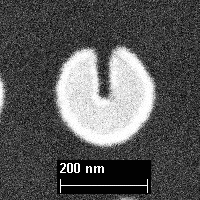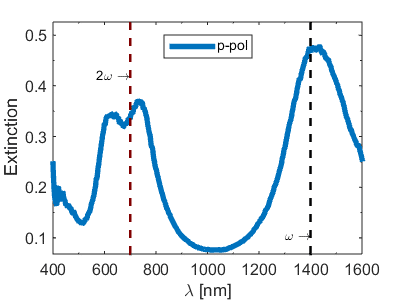
Ultrafast Coherent Nonlinear Response in Arrays of Multipolar Plasmonic Resonators
Nonlinear phenomena are widely studied in nano-optics, and are often implemented in synergy with plasmonic effects to provide strong field enhancement. Arrays of plasmonic nanostructures can form the basis for the development of efficient active metasurfaces with designed coherent and ultrafast optical functionalities needed in a range of applications requiring for example frequency conversion or efficient integrated quantum sources. This work is developed within this context and aimed at gaining the understanding necessary to develop coherent nonlinear metasurfaces rationally.
The unit cell of the metasurface we study (fig. 1a) is a 200 nm wide, 30 nm high Au cut disc. It is designed to support plasmonic resonances at both fundamental and harmonic frequencies. The extinction spectrum (fig. 1b) exhibits a Fano resonance in the visible and a magnetic dipole resonance in the near-IR, both optically active due to the presence of the slit [1] and at the basis of the strong coherent response of the metasurface.
We experimentally study and discuss the dispersion of both second and third-order nonlinear processes produced by this structure (fig. 2) with a particular focus on the mechanisms enabling their optically-controlled modulation at the sub-picosecond time scale. The experiments, including pump-probe spectroscopy, are rationalized using theoretical considerations and numerical computations.



[1] M. W. Klein, M. Wegener, N. Feth, and S. Linden, “Experiments on second-and third-harmonic generation from magnetic metamaterials,” Opt. Express, vol. 15, no. 8, pp. 5238–5247, 2007.
Powered by Eventact EMS